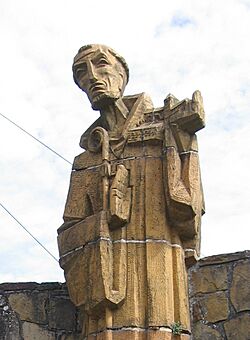Gérard of Brogne facts for kids
Quick facts for kids Saint Gérard of Brogne |
|
|---|---|

Statue of Saint Gerard, behind which stands the church of Saint-Gérard.
|
|
| Born | ~895 |
| Died | October 3, 959 |
| Venerated in | Roman Catholic Church |
| Major shrine | Saint-Gérard, Namur |
| Feast | October 3 |
| Patronage | Saint-Gérard, Namur |
Saint Gérard (also known as Sint-Djuråd in Walloon) lived from about 895 to October 3, 959. He was a very important person who started Brogne Abbey. He also helped change and improve eighteen other monasteries, making them follow the strict rules of the Benedictine way of life.
His Early Life
Gérard was born around the year 895 in a place called Staves, which is in the Namur region. His father, Stance, came from a powerful family of dukes. His mother, Plectrude, was the sister of Bishop Stephen of Liège.
Gérard first started his career as a soldier. He later took a small family chapel and made it much bigger. He then had it run by a group of priests called canons.
Becoming a Monk
Around the year 917, Gérard was in Paris for work. He stayed at the Abbey of St-Denis. He was so impressed by how the monks lived their lives that he decided to join them.
After sorting out his personal matters, he became a monk. Even as a monk, he still cared about the church he had built at Brogne. The leader of Saint-Denis Abbey gave him a special relic (a holy item) of Saint Eugenius for the people at Brogne. In 923, the church at Brogne was given land in a place called Hesbaye.
Around 928, Gérard became a priest. He went back to Brogne and changed the church there. He replaced the priests who were not following the rules strictly with monks. After this, he moved to a small room near the monastery to live an even stricter life.
Reforming Monasteries
The Archbishop of Cambrai asked Gérard to help improve the community of Saint-Ghislain in Hainault. There, he again replaced the canons with monks.
Gérard eventually became the head of eighteen other abbeys in the area that is now Belgium. He made sure that these monasteries followed very strict rules for monks. For example, when he reformed the Abbey of Saint Bertin in 944, some monks who disagreed with the changes left and went to King Edmund I of England.
Towards the end of his life, Gérard put other leaders in charge of the different abbeys he had reformed. He traveled all the way to Rome to get a special document from the Pope. This document confirmed the special rights and protections for Brogne Abbey.
After returning from Rome, he visited all the communities he had helped reorganize one last time. Then, he went back to Brogne, where he passed away in October 959. The abbey at Brogne was later renamed Saint-Gerard Abbey in his honor.
Veneration
Saint Gérard's feast day (a special day to remember him) is celebrated on October 3. This day is observed in the dioceses (church regions) of Namur, Ghent, and Liege. He is listed in the Roman Martyrology, which is a book that lists saints and their feast days.
Some of his relics, which are believed to be real, are kept in Saint-Gérard, the abbey of Maredsous, Aubange, and Ghent (in the church of Notre-Dame).

